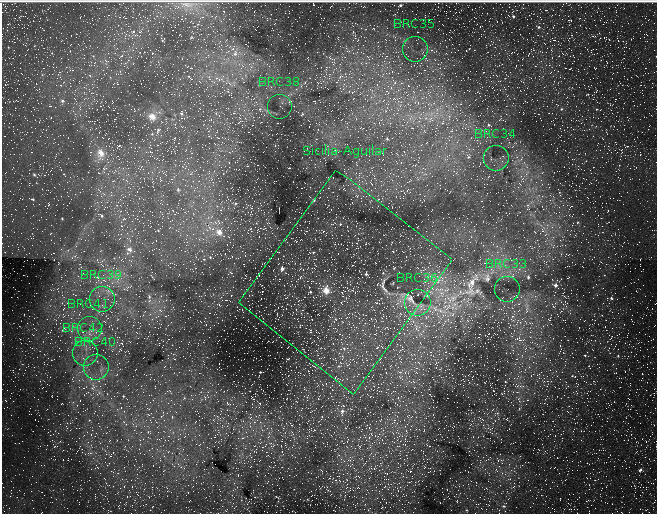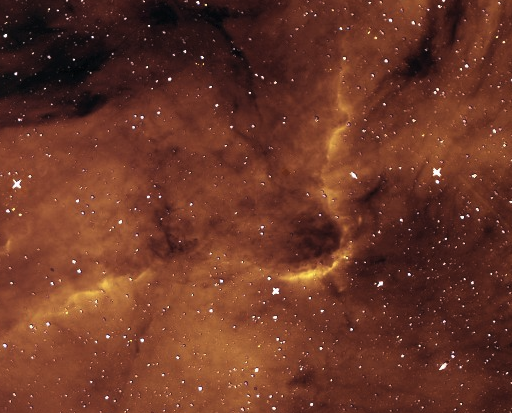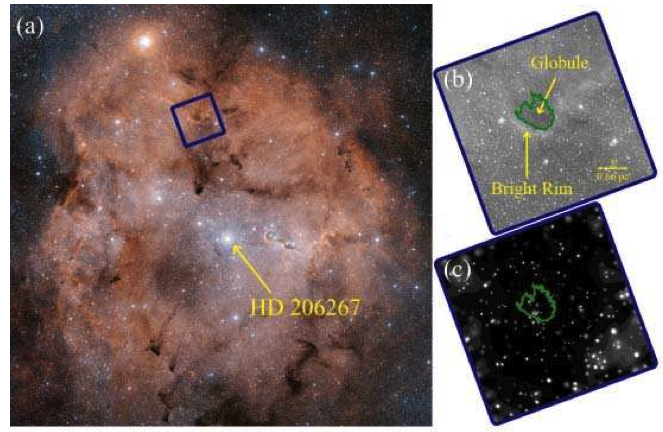Difference between revisions of "Jackie BRC 38"
| Line 44: | Line 44: | ||
| align="center" style="background:#f0f0f0;"|'''URL''' | | align="center" style="background:#f0f0f0;"|'''URL''' | ||
|- | |- | ||
| − | | saurin et al. 2012 ||the embedded cluster or assoiciation trumpter 37 in ir 1396||2MASS obsevations of BRC 38 ||http://arxiv.org/pdf/1201.2704.pdf | + | | saurin et al. 2012 ||the embedded cluster or assoiciation trumpter 37 in ir 1396||2MASS obsevations of BRC 38<BR><BR>Primary focus Trumpter 37, but analyzed 2Mass photometry of 11 BRCs in IC 1396 including BRC 38. All associated with IRAS sources (prob protostars) massive nearby star HR 8281 may have triggered sequential star formation via winds and UV. Photometric errors </= 0.1 mag removed for stars less than 0.5 arcmin radius for BRC 38 b/c high absorption? Relatively high central densities = small star clusters. Getman et al 2007 found sequential star formation evidence for BRC 38, spatial gradient stellar age in direction to triggering star as well as YSOs. BRC 38 stellar mass of ~15Mo assumed representative of area. Lists ra/dec, angular and linear dist to HR 8281 --Peggy Piper 12:23, 21 February 2012 (PST) ||http://arxiv.org/pdf/1201.2704.pdf |
|- | |- | ||
| Barensten et al. 2011||T tauri candidates and accretion rates using IPHAS: method and application to IC 1396||Includes BRC 38 which is called cloud E; Looking for YSOs in all of 1396; list 158 candidates; uses IPHAS survey data - Halpha, r, I filters on isaac newton telescope||http://arxiv.org/pdf/1103.1646v1.pdf | | Barensten et al. 2011||T tauri candidates and accretion rates using IPHAS: method and application to IC 1396||Includes BRC 38 which is called cloud E; Looking for YSOs in all of 1396; list 158 candidates; uses IPHAS survey data - Halpha, r, I filters on isaac newton telescope||http://arxiv.org/pdf/1103.1646v1.pdf | ||
Revision as of 20:23, 21 February 2012
Location of BRC 38
I need a picture in my head. I found these helpful. The first is the one Luisa already put up. The 2nd is from APOD (http://apod.nasa.gov/apod/ap110425.html). The 3rd is from Getman et al. 2006
Information about BRC 38
Bright Rimmed Cloud 38 in IC 1396. Since it is located in the north part of IC 1396 is it often referred to as IC 1396N.
It has a C shape with the southern edge as the brightest part (Pottasch et al. 1956).
Location with intermediate mass protostars, though some (Ogura & Sugitani 1999) suggest there is probably a lot of low mass formation going on too. Wang et al. 2009 believes potential for high mass stars forming here also.
H2 jets found (Saraceno et al. 1996; Nisini et al. 2001)
Herbig-Haro objects found (Repurth et al. 2003
Observed in many wavelengths - it would be good to get the specific wavelengths in each band
- optical (IPHAS, several optical - including Yerkes in the 1950s - coming from Chicago I have to cheer!!),
- infrared (2MASS,
- radio (IRAM & BIMA)
- x-ray
Questions
I am sure there are a lot more!! After fooling around with wiki editing, this is all that is left in my head at present.
1. One IRAS (Infrared Astronomical Satellite) location (IRAS 21391+5802) seems to be the central point or at least this location that keeps coming up. What is this?
2. LWS spectrum - is this as simple as long wavelength?
3. Still unclear on what exactly the following are. I have looked them up but they are not clear in my head - maser, Herbig-Haro objects, FIR colors, MIP colors
4. When we talk about BRC 38, are we talking about the whole C rim and globular area it half encircles? Where does the IRAS source 21391+5802 fit in our picture?
5. Is submillimeter wavelengths (SUBA) infrared or microwave?
6. Is HD 206267 affecting the whole region with its radiation?
Search phrases
- BRC 38
- sfo 38
- 21:40:42+52:16:13
- 21391+5802
- IC 1396N
- Cepheus OB2
- IMYSO
Articles
| Author Date | Article Title | Comments - After brief overview of article, not careful reading - Luisa's Notes are from last year | URL |
| saurin et al. 2012 | the embedded cluster or assoiciation trumpter 37 in ir 1396 | 2MASS obsevations of BRC 38 Primary focus Trumpter 37, but analyzed 2Mass photometry of 11 BRCs in IC 1396 including BRC 38. All associated with IRAS sources (prob protostars) massive nearby star HR 8281 may have triggered sequential star formation via winds and UV. Photometric errors </= 0.1 mag removed for stars less than 0.5 arcmin radius for BRC 38 b/c high absorption? Relatively high central densities = small star clusters. Getman et al 2007 found sequential star formation evidence for BRC 38, spatial gradient stellar age in direction to triggering star as well as YSOs. BRC 38 stellar mass of ~15Mo assumed representative of area. Lists ra/dec, angular and linear dist to HR 8281 --Peggy Piper 12:23, 21 February 2012 (PST) |
http://arxiv.org/pdf/1201.2704.pdf |
| Barensten et al. 2011 | T tauri candidates and accretion rates using IPHAS: method and application to IC 1396 | Includes BRC 38 which is called cloud E; Looking for YSOs in all of 1396; list 158 candidates; uses IPHAS survey data - Halpha, r, I filters on isaac newton telescope | http://arxiv.org/pdf/1103.1646v1.pdf |
| choudhury et al. 2010 | Triggered star formation and YSO population in Bright Rimmed SRO 38 | 44 YSOs identified in brc 38 - evidence for radiation driven implosion (RDI); spizter IRAC & MIPS data, optical BVRI | http://arxiv.org/pdf/1005.1841v1.pdf |
| Morgan et al. 2010 | Ammonia observations of bright-rimmed clouds: establishing a sample of triggered protostars | Radio observations (Green Bank) of brcs; furthering earlier work of morgan, confirming brc is triggered star formation site | http://arxiv.org/pdf/1006.0833v1.pdf |
| Crimier et al. 2010 | Physical structure of the envelopes of intermediate-mass protostars | a study that says that the mass of the final star of a protostar is linked to the mass of the envelope around the protostar, not the density of the parent cloud - backbground on IM protostars?? | http://arxiv.org/pdf/1005.0947v1.pdf |
| Ogura 2010 | Triggered star formation assoicated with HII regions | Not really about BRC 38 but discusses curent state of triggered star formation theory | ASI Conference Series, 2010, Vol 1, pp 19-25 |
| beltran et al. 2009 | The stellar population and complex structure of the bright-rimmed cloud ic 1396N | A study through J< H< K\' filters; 736 sources found in all 3 bands (filters); h2 emission shows jet like structure | http://arxiv.org/pdf/0902.4543v1.pdf |
| Morgan L. K., Urquhart J. S., Thompson M. A., 2009 ON LAST YEAR'S LIST |
CO observations towards bright-rimmed clouds | can\'t get paper Luisa's notes: JCMT (CO) observations. both 27 and 34 in here. 22 arcsec resolution! (see Resolution and their fig 2 here.) Likely last of his thesis, or first of his postdoc. (Look, his address changed, so this was published while he was a postdoc, but it's the same collaborators as before at his old institution, so my guess it's leftover thesis work.) They think 27 has been triggered, 34 not; this provides a nice compare-and-contrast opportunity for our write-up. Quick read. |
2009, MNRAS, 400, 1726 |
| fuente et al. 2009 | Dissecting an intermediate-mass (IM) prostar | A look at IRAS 21391+5802 emissions of N2H+, CH3CN, CS, BIMA (1.2mm & 3.1mm) | http://arxiv.org/pdf/0909.2267v1.pdf |
| Wang et al. 2009 | The relation between 13CO j=2-1 line width in moelcular clouds and bolometric luminosity of associated IRAS sources | IRAS 21391+5802 - suggests that it is a star forming cluster where high-mass stars will form | http://arxiv.org/pdf/0909.3312v1.pdf |
| Chauhan et al. 2009 ON LAST YEAR'S LIST |
Triggered star formation & evolution of t-tauri stars in and around BRC | Study that looked at ages of star forming clusters. Seems to have a lot of background material on BRC 38 | 2009, MNRAS, 396, 964 |
| Morgan et al. 2007 ON LAST YEAR'S LIST |
A scuba survey of BRC | BRC 38 included in this study with SUBA data (submillimeter - microwave??); Luisa's notes: SCUBA submm survey (450+850 um) plus IRAS (12, 25, 60, 100 um), MSX, and 2MASS (erroneously identified as 2mm but really 2 micron). both 27 and 34 in here. next part of a PhD thesis. lots of nice overview, summary (as would be expected for a thesis) spread throughout article. seems to be a really long paper, but is almost all figures in the appendix. relevant issues: how the objects they are talking about (at long and short wavelengths) compare to what we see in our images (see Resolution and their, e.g., fig 4). Forward reference to Spitzer data analysis like ours but then says have already looked for GLIMPSE, 24 um obs. They are only looking at low-res flux densities. Appendix may be useful for scavenging additional targets if we want to do more analysis on more targets. |
2008, A&A, 477, 557 |
| Neri et al. 2007 | The IC 1396N proto-cluster at a scale of ~250 AU | observations in millimeter range to help develop understanding of formation of clusters vs individual star formation | http://arxiv.org/pdf/0705.2663v1.pdf |
| Getman et al. 2007 | X-ray study of triggered star formation and protostars in IC 1396N | x-ray sources in the globule of ic 1396N; good pictures to help with the visualization of 1396N and these sources; evidence of sequential star formation | http://arxiv.org/pdf/astro-ph/0607006v2.pdf |
| Patel et al. 2007 | Submillimeter array observations of 321 ghz water maser emission in cepheus a | No don\'t think there is anything here | http://arxiv.org/pdf/astro-ph/0702696v1.pdf |
| Connelley et al. 2006 | Infrared Nebulae around Young stellar objects | IRAS 21391+5802 - images show jet-like nebula and large patches of nebulosity | http://arxiv.org/pdf/astro-ph/0611634v1.pdf |
| Valdettaro et al. 2005 ON LAST YEAR'S LIST |
h2o maser emission from bright rimmed clouds in the northern hemisphere | H2O maser studied in brc 38; points to paper Valdettaro et al. 2005b which is supposed to be about analysis of BRC 38. Luisa's notes: 22.2 GHz (=1.35 cm if I did my math right). Really nice intro summarizing the big picture. Following up on Morgan and similar work asserting high-mass stars forming in BRCs by looking for masers. Our objects observed, not detected. Finding lots of non-detections, suggesting that low-mass stars forming instead. Nice, short writeup of basically a non-result, and I think they've gotten the interpretation spot-on. |
2005, A&A, 443, 535 |
| Beltran et al. 2004 | The dense moelcular cores in IRAS 21391 +5802 region | Three sources found with BIMA (??) observations in 21391+5802; Hard to read as they are trying to use data to fit/model how gas is emitted from the core | http://arxiv.org/pdf/astro-ph/0407102v1.pdf |
| Reipurth et al. 2003 | Blowout from IC 1396N: The emergence of Herbig-Haro objects in the vicinity of bright-rimmed clouds | Herbig-Haro flow (HH 777) found coming out of ic 1396N; located at 214041.6+581638 (in IR, I think) | 2002, ApJ, 123:2597-2626 |
| Ogura, et el 2002 ON LAST YEAR"S LIST |
Halpha emission stars and Herbig-Haro objects in and around BRC | Part of Luisa's Notes from last year: Most recent of the Sugitani series of four. Using Halpha to look for YSOs, following up their other work. relevant issues: using multiple wavelengths to find YSOs (see Finding cluster members), spatial resolution (see Resolution), caveats with finding candidates. Nice intro, summary of larger issues, discussion of results. | http://iopscience.iop.org/1538-3881/123/5/2597/pdf/201506.web.pdf |
| Beltran et al. 2002 | IRAS 21391+5802: The Molecular Outflow and its Exciting source | VLA and BIMA observations of dust and gas surrounding IRAS source; 3 sources isolated with BIMA, each a YSO | http://arxiv.org/pdf/astro-ph/0203206v1.pdf |
| Codella et al. 2001 | Star formation in the BRC of IC 1396N | The density of several different molecular outflows (dense areas of particular molecules)in the globule looked at with 30m IRAM and OVRO interferometer. Demonstrates this area very complex. | Astron. Astrophys., 376, 271-287 (2001) |
| Nisini et al. 2001 | Multiple H2 protostellar jets in the bright-rimmed globule IC 1396-N | 1st detection of H2 jets from YSO. Are these HH objects? | A&A 376, 553{560 |
| Slysh et al. 1999 | Prootoplanetary disk and/or bipolar outflow traced by h2o masers in ic 1396n | Description of 3 models that may explain how masers form; Gives background on IC 1396 | http://iopscience.iop.org/0004-637X/526/1/236/pdf/39770.web.pdf |
| Ogura & Sugitani 1999 | A large number of Halpha Emission Stars associated with BRCs | Supports \"small-scale sequential star formation\"; suggests low-mass stars formating in area of high-mass star forming area | Proceedings of Star Formation, 1999, pg 381-382 |
| Sugitani et al. 1999 | Small-Scale Sequential Star Formtion in Bright-Rimmed Clouds | Discussion of small-scale sequential star formation hypothesis | Proceedings of Star Formation, 1999, pg 358-364 |
| Saraceno et al. 1996 | LWS observations of the bright-rimmed globule IC 1396N | spectrum of co, oh, h2o are detected in the ISO-LWS spectrum - not sure what that is?? | Astron. Astrophys. 315, L293–L296 (1996) |
| Saraceno et al. 1996 | An evolutionary diagram for young stellar objects | background - but not sure I understand it | Astron. Astrophys, 309, 827-839 |
| Weikard et al. 1996 | the structure of the IC 1396 region | Discussion of structure of 1c 1396 and the central star O6.5 (HD 206267) radiation on clumping and structure/location of yso; shows locations of yso in brc 38 from their data | Astron. Astrophys, 309, 581-611 |
| Sugitani et al. 1991 ON LAST YEAR"S LIST |
A catalog of BRC with iras point sources | Just a list of point sources they invesigated - brc 38 on the list Part of Luisa's notes: the original SFO, origin of "BRC" terminology, numbers 1-44. covers the northern hemisphere. has nice intro/summary of what's going on in BRCs, CGs, etc. Nice approach of combining two large surveys -- POSS and IRAS; nice clear discussion of weed-down process. |
1991, ApJS, 77, 59 |
| Sugitani et al. 1989 | Star formation in bright-rimmed globules: evidence for radiation-driven implosion | Argument for rdiation-driven implosion method of star formation. | 1989, ApJ, 342:L87-90 |
| Pottasch et al. 1956 | a study of bright rims in diffuse nebulae | Early work describing the location, shape of, density of, brightness of bright rim clouds in several nebula, including IC 1396 and Brc 38 | Bulletin of Astro. Instit. of the Netherlands, Vol 13, 471, 77-88 |


